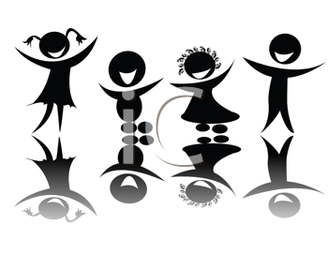CATCH 'EM BEING GOOD!

Aiden and Jonathan Portnoy on the first day of school, 2011
I believe each student should be responsible for his or her own behavior and in order to take ownership of the class rules, he or she should be involved in writing them. The class will be guided to some version of these rules:
The first few days of school will be spent talking about, explaining, reviewing and role playing the rules to ensure that each student has a full understanding of what is expected of him or her. I believe in catching my students adhering to the rules, therefore I have a reward system in place. When I “catch” a child following the rules He or she receives a ticket, which he or she then writes his or her name on and then drops into a box on my desk. In the lower grades, I draw 5 names at the end of the day to go to the treasure box (containing stickers, pencils, erasers and such). In the upper grades, I draw 5 names at the end of the week. The more times a student’s name goes into the box, the greater his or her chances are to go to the treasure box (also a good lesson on cause/effect and probability).
I also employ the use of a discipline chart in the 1st grade through 5th grade classroom. The rules are clearly listed (in the lower grades words and illustrations are used) and the chart contains a pocket for each child, labeled with a number instead of a name. Each pocket contains 4 strips of paper (1 each of green, yellow, red and purple). Any time a student breaks a rule, he or she must change the strip in his or her pocket to the next color.
The colors and their meanings are as follows:
For kindergarten, a modified stoplight is employed. It contains a smiley face, a green light, a yellow light, a red light and a sad face. Each child has a clip with his or her number on it and all clips start on the smiley face each morning. If a rule is broken, the student must move his or her clip to the next color.
The colors and meanings are as follows:
*There is also a serious offense clause which states that any child causing bodily harm to another will be sent to the office and have his or her parents called before he or she is allowed to return to the classroom. (This clause will be modified to fit the rules of the school pertaining to this particular offense.)
For kindergarten through 2nd grade I send home a daily report along with homework assignments. The daily report is to be signed by a parent each day as part of the homework. In grades 3-5 I send home a weekly report for the previous week in the Monday folder unless otherwise is needed based on an individual child’s level of responsibility. A copy of the discipline plan goes home at the beginning of the school year to be signed by the parent, child and teacher and stored in the child’s portfolio.
I like to make my classroom a fun and comfortable place for all my students. If there is a week when all the student cards are consistently on green we will have a small class celebration (usually a special snack provided by the teacher and an hour of board games at the end of the day on Friday).
I believe in being firm, fair and consistent. The classroom needs to be a place where everyone is accepted and respected. In this kind of environment, all children can learn and live up to his or her potential.
- Always be nice and respectful to others.
- Be courteous when others are speaking.
- Use our best manners in all areas of the school.
- Be prepared for class – objects and attitudes.
The first few days of school will be spent talking about, explaining, reviewing and role playing the rules to ensure that each student has a full understanding of what is expected of him or her. I believe in catching my students adhering to the rules, therefore I have a reward system in place. When I “catch” a child following the rules He or she receives a ticket, which he or she then writes his or her name on and then drops into a box on my desk. In the lower grades, I draw 5 names at the end of the day to go to the treasure box (containing stickers, pencils, erasers and such). In the upper grades, I draw 5 names at the end of the week. The more times a student’s name goes into the box, the greater his or her chances are to go to the treasure box (also a good lesson on cause/effect and probability).
I also employ the use of a discipline chart in the 1st grade through 5th grade classroom. The rules are clearly listed (in the lower grades words and illustrations are used) and the chart contains a pocket for each child, labeled with a number instead of a name. Each pocket contains 4 strips of paper (1 each of green, yellow, red and purple). Any time a student breaks a rule, he or she must change the strip in his or her pocket to the next color.
The colors and their meanings are as follows:
- Green – great behavior, no issues that day
- Yellow – verbal warning that behavior is unacceptable
- Red – time out, behavior is out of hand
- Purple – note home to parents
For kindergarten, a modified stoplight is employed. It contains a smiley face, a green light, a yellow light, a red light and a sad face. Each child has a clip with his or her number on it and all clips start on the smiley face each morning. If a rule is broken, the student must move his or her clip to the next color.
The colors and meanings are as follows:
- Smiley face – great job, keep it up!
- Green – private verbal warning
- Yellow – private verbal warning and time out
- Red – private verbal warning, time out and privileges taken away for the day (i.e.- classroom jobs)
- Sad face – note home to parents
*There is also a serious offense clause which states that any child causing bodily harm to another will be sent to the office and have his or her parents called before he or she is allowed to return to the classroom. (This clause will be modified to fit the rules of the school pertaining to this particular offense.)
For kindergarten through 2nd grade I send home a daily report along with homework assignments. The daily report is to be signed by a parent each day as part of the homework. In grades 3-5 I send home a weekly report for the previous week in the Monday folder unless otherwise is needed based on an individual child’s level of responsibility. A copy of the discipline plan goes home at the beginning of the school year to be signed by the parent, child and teacher and stored in the child’s portfolio.
I like to make my classroom a fun and comfortable place for all my students. If there is a week when all the student cards are consistently on green we will have a small class celebration (usually a special snack provided by the teacher and an hour of board games at the end of the day on Friday).
I believe in being firm, fair and consistent. The classroom needs to be a place where everyone is accepted and respected. In this kind of environment, all children can learn and live up to his or her potential.

